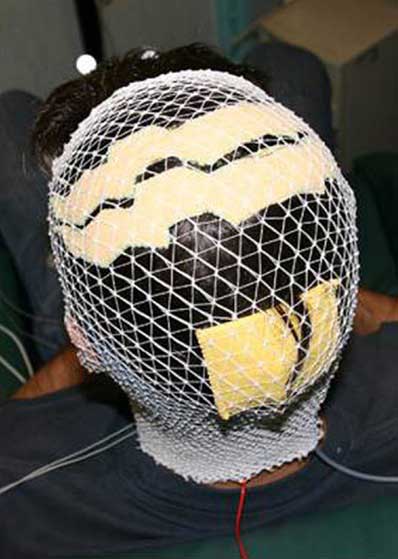Things have moved on from there and luckily we now have a randomised controlled trial with a sufficient sample size (n=135) of patients suffering from chronic low back pain and shown that tDCS – at least in this population and using a paradigm of 2mA for 20 mins on 5 consecutive days over the motor cortex – does nothing to reduce the perceived intensity of back pain or the disability associated with chronic low back pain (Luedtke et al., 2015). The results were not only not statistically significant, there wasn’t even a trend into the right direction
Tag Archives: pain
tDCS clinical research – recent highlights: Pain
The developers of Starstim, Neurolectrics, have a blog where they frequently discuss tDCS (and EEG). Here’s a snippet from their latest on tDCS & pain. Hit the link below to their full article.
Is transcranial current stimulation tCS, including direct current, tDCS, alternating current, tACS, or random noise stimulation tRNS effective? Now that is a good and difficult question! Let me try to review recent developments. In a recent post I provided an overview of tCS in Stroke. Here I do the same but for Pain. Please let me know if you think I am missing some important one! I have relied on Google Scholar and also PubMed to carry out the search, including the terms of tDCS, tACS, tRNS as well as Pain since 2012 and till Sep 2013.
tDSC Papers of Note April 2013
Regional personalized electrodes to select transcranial current stimulation target (pdf)
…with the present work we developed a procedure to properly shape the stimulating
electrode.

(The familiar looking square electrodes were the reference electrodes.)
Tags: electrodes, tACS
The Sertraline vs Electrical Current Therapy for Treating Depression Clinical StudyResults From a Factorial, Randomized, Controlled Trial (pdf)
At the main end point, there was a significant difference in Montgomery-Asberg Depression Rating Scale scores when comparing the combined treatment group (sertraline/active tDCS) vs sertraline only, tDCS only, and placebo/sham tDCS… There were 7 episodes of treatment-emergent mania or hypomania, 5 occurring in the combined treatment group.
Tags: depression
Noninvasive transcranial direct current stimulation over the left prefrontal cortex facilitates cognitive flexibility in tool use (pdf)
The results support the hypothesis that certain tasks may benefit from a state of diminished cognitive control.
And a related news story discussing the same paper.
Brain hacking: Electrifying your creative side
Each person was shown pictures of everyday objects and asked to come up with a new uses for them.
The group which received the TDCS muting the left prefrontal cortex was better in coming up with unusual uses than the others — and did it faster.
Tags: creativity, Sharon Thompson-Schill, cathodal stimulation,
Orchestrating neuronal networks: sustained after-effects of transcranial alternating current stimulation depend upon brain states (pdf)
Long lasting after-effects foster the role of tACS as a tool for non-invasive brain stimulation and demonstrate the potential for therapeutic application to reestablish the balance of altered brain oscillations.
Tags: tACS
Different Current Intensities of Anodal Transcranial Direct Current Stimulation Do Not Differentially Modulate Motor Cortex Plasticity (pdf)
targeting M1 …10 minutes of anodal tDCS at 0.8, 1.0, and 1.2 mA
These results suggest that the aftereffect of anodal tDCS on facilitating cortical excitability is due to the modulation of synaptic mechanisms associated with long-term potentiation and is not influenced by different tDCS intensities.
Tags: M1, dosage
Transcranial direct-current stimulation increases extracellular dopamine levels in the rat striatum (pdf)
Following the application of cathodal, but not anodal, tDCS for 10 min, extracellular dopamine levels increased for more than 400 min in the striatum. There were no significant changes in extracellular serotonin levels.
Tags: dopamine
Spark of Genius: A new technology promises to supercharge your brain with electricity. Is it too good to be true?
Surprisingly good pop-sci overview of where we’re at with tDCS. Chock full of relevant links.
Using computational models in tDCS research and clinical trials (pdf)
Hypothesis: Appropriately applied computational models are pivotal for rational tDCS dose selection.
Tags: Comptational modeling, Marom Bikson,
Boosting brain functions: Improving executive functions with behavioral training, neurostimulation, and neurofeedback (pdf)
This review provides a synopsis of two lines of research, investigating the enhancement of capabilities in executive functioning: a) computerized behavioral trainings, and b) approaches for direct neuromodulation (neurofeedback and transcranial electrostimulation).
Tags: cognitive enhancement
Focal Modulation of the Primary Motor Cortex in Fibromyalgia Using 4×1-Ring High-Definition Transcranial Direct Current Stimulation (HD-tDCS): Immediate and Delayed Analgesic Effects of Cathodal and Anodal Stimulation (pdf)
We found that both active stimulation conditions led to significant reduction in overall perceived pain as compared to sham.
Tags: Fibromyalgia, HD-tDCS, Marom Bikson, pain
Articles of Note – March 2013
(What happened to February?)
Transcranial Direct Current Stimulation (tDCS) of the visual cortex: a proof-of-concept study based on interictal electrophysiological abnormalities in migraine (pdf)
with anodal tDCS turned out to be beneficial in MoA (migraine without aura patients) migraine attack frequency, migraine days, attack duration and acute medication intake significantly decreased during the treatment period compared to pre-treatment baseline
Tags: Migraine, visual cortex,
The Mental Cost of Cognitive Enhancement (pdf)
Stimulation to the the posterior parietal cortex facilitated numerical learning, whereas automaticity for the learned material was impaired. In contrast, stimulation to the dorsolateral prefrontal cortex impaired the learning process, whereas automaticity for the learned material was enhanced.
Wired Version
New Scientist Version
Tags: Roi Cohen Kadosh,
Keith Spalding’s Simple DIY TDCS circuit using CRDs
A DIY schematic for tDCS using CRDs for current regulation.
Tags: DIY, CRD
Noninvasive transcranial direct current stimulation over the left prefrontal cortex facilitates cognitive flexibility in tool use
…we hypothesized that cathodal (inhibitory) transcranial direct current stimulation (tDCS) will facilitate performance in a flexible use generation task.
The results support the hypothesis that certain tasks may benefit from a state of diminished cognitive control.
Tags: inhibitory benefits,
When Anger Leads to Rumination
Induction of Relative Right Frontal Cortical Activity With Transcranial Direct Current Stimulation Increases Anger-Related Rumination
…results suggest that anger associated with greater relative left frontal cortical activity predicts approach-oriented aggressive action, whereas anger associated with greater relative right frontal cortical activity predicts inhibited rumination.
Potential of transcranial direct current stimulation shown in fibromyalgia
Transcranial direct current stimulation delivered focally to the left primary motor cortex of patients with fibromyalgia significantly reduced perceived pain compared with sham stimulation in a proof-of-principle pilot trial.
Tags, fibromyalgia, pain
tDCS Recent Activity 12/12 – 1/13
A lot of the ‘pop sci’ articles are drawing on the results of only a few studies. Hopefully we’ll get affirmation of the efficacy of tDCS in cognitive enhancement soon.
Does Passing A Small Current Through Your Brain Really Make You Smarter?
Excellent update from Giulio Ruffini of Neuroelectrics. Full of links to relevant papers.
tDCS and Stroke: What We Know So Far (Jan 2013)
As far as I can tell, this is a new development in understanding the mechanism for the mediation of pain using tDCS.
Immediate effects of tDCS on the μ-opioid system of a chronic pain patient
To our knowledge, we provide data for the first time in vivo that there is possibly an instant increase of endogenous μ-opioid release during acute motor cortex neuromodulation with tDCS.
(And the pop-sci media follow-up Electrical Current Can Unlock The Seriously Good Drugs In Your Brain and Happiness Is a Warm Transcranial Direct Current Electrode)
A lot of research is going on right now into understanding where exactly, current if flowing.
The electric field in the cortex during transcranial current stimulation
The aim of this study was to investigate the effect of tissue heterogeneity and of the complex cortical geometry on the electric field distribution.
Some context.
A pioneer work on electric brain stimulation in psychotic patients. Rudolph Gottfried Arndt and his 1870s studies.
Today’s brain stimulation methods are commonly traced back historically to surgical brain operations. With this one-sided historical approach it is easy to overlook the fact that non-surgical electrical brain-stimulating applications preceded present-day therapies.
Mental Practice, or MP is practicing doing something without actually doing it. A musician imagining playing their instrument for instance. This study measured quality of handwriting with the non-dominant hand while using tDCS.
Site-specific effects of mental practice combined with transcranial direct current stimulation on motor learning
In conclusion, our results suggest that MP-induced effects in improving motor performance can be successfully consolidated by excitatory non-invasive brain stimulation on the M1 and left DLPFC.
Marom Bikson’s ‘tDCS State of the Art’ Lecture Now On YouTube
There’s just so much going on in tDCS right now that it’s hard to keep track. Coupled with the fact that I don’t have a Uni account that lets me access new paper (although I’ve had some help there from time to time). One of my objectives is to understand what’s going on well enough to present you with an accurate overview of what’s new. But lately research papers are coming so quickly that it’s been overwhelming.
But here’s my take-away from Marom’s lecture: Electrode placement does not necessarily correlate with current flow! At least not the way one might assume. Watch the videos to get a clear picture.
tDCS Clinical Trials Seeking Volunteers
There seems to be a LOT of activity going on in the medical profession around tDCS. You can monitor ClinicalTrials.gov to keep an eye on new and recruiting tdcs studies. If you start here and modify your search with your location, you may find a study in your area.
Devices mentioned in the studies:
Eldith DC stimulator (13 mentions) [Also translated from the German neuroconn.de]
Magstim Company Ltd. UK (1 mention)
Soterix tDCS device (1 mention)
| 8 | Recruiting | Brain Stimulation-aided Stroke Rehabilitation: Neural Mechanisms of Recovery
|
||||
| 9 | Recruiting | Effects of Transcranial Direct Current Stimulation (tDCS) on Chronic Pain Due to Burn Injury
|
||||
| 10 | Recruiting | Anodal Transcranial Direct Current Stimulation (tDCS) in the Treatment of Tobacco Addiction
|

